The ARS Plant Awards Committee has selected the Rhododendron of the Year awards for 2009.
Because of climate differences, the committee selected plants for seven regions: an elepidote,
a lepidote, a deciduous azalea and an evergreen azalea. The Vireya/Swisher Award is given to a
vireya rhododendron.
The first criterion was that the plant perform well in the region, even for a novice. That
plant had to exhibit good form, foliage and flowers, to prove itself cold and heat hardy
for the region, and to show resistance to pests and diseases. In addition, the plant had to
be available in the nursery trade and the name registered with the ARS.
Northeastern Region
'Yaku Prince'
: Elepidote ('King Tut' x
R. yakushimanum
'Koichiro Wada').
A midseason bloomer with red buds opening as frilly rose pink flowers with a lighter center,
held in a ball-shaped truss; a well-branched, compact plant, growing to about 1' tall by 3'
wide in ten years and hardy to -10°F; olive green leaves with a slight indumentum; perhaps
the best cultivar from this cross by Tony Shammarello.
R. keiskei : Lepidote. A Japanese native, usually low growing and compact (to 2' in ten years), but leggy and open on occasion; the pale lemon yellow, funnel shaped flowers appear in the early midseason; long leaves, often bronze or reddish when young, and hardy to -5°F.
'Weston's Innocence' : Deciduous Azalea (probably R. arborescens X R. viscosum ). Abundant fragrant white flowers on a compact but upright grower; blooms in mid to late June and grows to 5' in ten years; the bronze-green leaves are mildew resistant and turn deep red in the fall; this vigorous grower will take full sun and is hardy to -25°F; a Mezitt hybrid.
'Wintergreen' : Evergreen Azalea ( R. nakaharae open-pollinated). Low growing and late blooming North Tisbury hybrid with 2" medium cherry-red flowers; compact and spreading habit makes it one of the best azaleas for use as a groundcover; dark green leaves and excellent winter foliage. (Not to be confused with the white Shammarello hybrid 'Winter Green'.)

|

|
|
|---|---|---|
Elepidote: 'Yaku Prince' Photo by D. McKiver |
Lepidote: R. keiskei Photo by C. Bird |

|

|
|
|---|---|---|
Deciduous Azalea: R. 'Weston's Innocence' Photo by K. Theqvist |
Evergreen Azalea: 'Wintergreen' Photo by H. Greer |
Mid Atlantic Region
'Wheatley'
: Elepidote ('Westbury' x 'Meadowbrook'). Very popular in the eastern
areas of the United States; a well-branched plant, growing as wide as tall (5' in ten
years); the midseason blooms are funnel-shaped, with wavy lobes, very fragrant, and held
in large ball-shaped trusses of 16 rose-pink flowers; has glossy medium green leaves and
is hardy to -15°F; a Phipps hybrid that received the Award of Excellence from the ARS in
1973.
'Landmark' : Lepidote ('Counterpoint' x Carolina Rose Group). Seen from afar, this is the elusive red lepidote; closer observation shows the compact trusses of wavy-edged flowers to be purplish-red; a vigorous upright grower (4' in ten years), covered with flowers in the early spring and excellent bronze-purple color in winter; hardy to -20°F and very sun tolerant; another great Mezitt hybrid from Weston Nurseries.
'Old Gold' : Deciduous Azalea (unknown). Aptly named, with clusters of light orange-yellow flowers flushed pink with an orange blotch; a profuse bloomer, with flowers covering the broad and bushy plant; an Exbury hybrid, growing to 4' in ten years and hardy to -25°F.
'Koromo-shikibu' : Evergreen Azalea (possibly R. macrosepalum hybrid). A real attention getter with its unusual, narrow purplish-pink strap-like petals; a midseason bloomer with hairy light green leaves; low-growing into a spreading mound-like shape; grows to 4' in ten years and hardy to -15°F.

|

|
|
|---|---|---|
Elepidote: 'Wheatley' Photo by H. Greer |
Lepidote: 'Landmark' Photo by R.W. Mezitt |

|

|
|
|---|---|---|
Deciduous Azalea: 'Old Gold' Photo by H. Greer |
Evergreen Azalea: 'Koromo-shikibu' Photo by Harold Greer |
Southeastern Region
'Taurus'
: Elepidote ('The Honourable Jean Marie de Montague' x
R. strigillosum
). Impressively displays globular trusses of
glowing red, bell-shaped flowers with black speckling on the upper petal;
blooms early midseason; the deep green leaves are held for three years, giving
a richly-clothed appearance; adorned with prominent and showy deep red buds in
winter; a vigorous plant, upright and spreading, growing to 6' in ten years;
hardy to -5°F; a Mossman hybrid.
'Windbeam' : Lepidote ('Conestoga' seedling). A very hardy (-25°F), early midseason bloomer; flowers opening white, tinged pale apricot, aging to white flushed light purplish pink, growing to 4' in ten years with small aromatic foliage; this Nearing hybrid received the ARS Award of Excellence in 1973.
'Gibraltar' : Deciduous Azalea (unknown). Has a large full truss of brilliant frilled orange flowers with a red flush, coming from deep crimson orange buds; compact growing habit, to 6' in 10 years; a midseason bloomer, hardy in zones 5a-8a; mildew resistant Knap Hill hybrid and one of the best and most reliable deciduous hybrids.
'Conversation Piece' : Evergreen Azalea ('Emile Russave' x [Gable's] 'Carol' x 'Eikan'). A low and broad dwarf or semi-dwarf plant with a dense horizontal branching structure; large 3" single flowers that are widely funnel-shaped with wavy-edged lobes; extremely variable in color, ranging from white to purplish-pink, sometimes in combination, and many with vivid purplish-red blotches; Robin Hill hybrid, hardy to -10°F, blooms late, and grows to 1' x 1' in 16 years.

|

|
|
|---|---|---|
Elepidote: 'Taurus' Photo by D. Irish-Hosler |
Lepidote: 'Windbeam' Photo by E. Philp |

|

|
|
|---|---|---|
Deciduous Azalea: 'Gibraltar' Photo by H. Greer |
Evergreen Azalea: 'Conversation Piece' Photo by D. Voss |
Great Lakes Region
'Pearce's American Beauty'
: Elepidote ('Mrs. Charles S. Sargent' x 'Doctor H.
C. Dresselhuys'). Frilly, strong purple-red flowers held in full ball-shaped trusses
of 18 flowers; a strong grower with dark green leaves that blooms late; has a broad
habit, growing almost as wide as tall reaching 6' in ten years; hardy to at least 0°F
and probably lower; an old timer, hybridized by Pearce in the 1930s.
'Angel Powder' : Lepidote ('Epoch' x white-flowered R. mucronulatum ). Large frilly white blossoms held in clusters of six flowers; has an upright, dense habit with large leaves; grows to 3' in ten years and blooms midseason; hardy to -15°F; like many Delp hybrids, not as well known as it should be.
'Narcissiflorum' : Deciduous Azalea (unknown). A great abundance of fragrant, double yellow flowers on a well-branching plant with an upright habit; tall grower (to 6' in ten years) with mildew resistant foliage; this late midseason bloomer is hardy to -15°F; hybridized by Rintz in the mid-19th century; received the Award of Merit and the First Class Certificate from the Royal Horticultural Society; sometimes incorrectly listed as 'Narcissiflora'.
'White Rosebud' : Evergreen Azalea ('Vervaeneanum Album' x 'Rosebud'). Ruffled double white flowers with a green throat resemble rosebuds; low, compact habit with glossy, dark foliage, reaching 3' by 3' in ten years; blooms midseason and hardy to -5°F; an Augie Kehr hybrid.

|

|
|
|---|---|---|
Elepidote: 'Pearce's American Beauty' Photo by H. Greer |
Lepidote: 'Angel Powder' Photo by S. Anderson |

|

|
|
|---|---|---|
Deciduous Azalea: 'Narcissiflorum' Photo H. Greer |
Evergreen Azalea: 'White Rosebud' Photo by H. Greer |
South Central Region
'Anah Kruschke'
: Elepidote (
R. ponticum
seedling). A hardy (to -15°F),
-eat and sun tolerant plant with funnel= shaped, reddish purple flowers with a deep
purple-red blotch in medium sized, tight ball-shaped trusses; excellent glossy dark
yellowish green foliage on a well-branched, compact plant growing to 5' in ten years;
late season bloomer is a Kruschke hybrid.
'Dora Amateis' : Lepidote ( R. minus Carolinianum Group x R. ciliatum ). Compact and low-growing (to 3' in 10 years), making an excellent foundation or border plant; a bushy shrub covered with pure white flowers with a spicy fragrance in early midseason; dense deep green foliage accented with bronze tones; often wider than tall and does well in full sun; hardy to -15°F; hybridized by Edmond Amateis; received the Award of Excellence from the American Rhododendron Society and the First Class Certificate from the Royal Horticultural Society.
'Chetco' : Deciduous Azalea ('Hugh Wormold' x 'Marion Merriman'). A midseason bloomer with large deep yellow flowers with a vivid orange blotch; a sturdy shrub with an upright habit, growing to 5' in ten years; a Slonecker hybrid, hardy to -15°F.
'Koromo-shikibu' : Evergreen Azalea. Evergreen Azalea (possibly R. macrosepalum hybrid). A real attention getter with its unusual, narrow purplish-pink strap-like petals; a midseason bloomer with hairy light green leaves; low-growing into a spreading mound-like shape; grows to 4' in ten years and hardy to -15°F.

|

|
|
|---|---|---|
Elepidote: 'Anah Kruschke' Photo by D. McKiver |
Lepidote: 'Dora Amateis' Photo by D. McKiver |

|

|
|
|---|---|---|
Deciduous Azalea: 'Chetco' Photo H. Greer |
Evergreen Azalea: 'Koromo-shikibu' Photo by C. Bird |
Northwestern
'Fantastica'
: Elepidote ('Mars' x
R. yakushimanum
'Koichiro Wada'). Rose-pink
flowers with a white throat cover this midseason bloomer, a compact plant with slightly
indumented dark green leaves; hardy to -15°F and growing to 3' in ten years; one of the
best of Hachmann's hybrids; does well in the eastern United States.
R. augustinii : Lepidote. The abundant flowers vary from white to pink to a deep violet blue, the color often varying from year to year; a midseason bloomer and a strong but compact grower with hairy, long dark green leaves; to 6' in ten years, hardy to about 0°F, and sun tolerant; native to the Sichuan region of China, and named for Augustine Henry who discovered it in 1886.
R. occidentale : Deciduous Azalea. The only azalea that grows naturally west of the Rocky Mountains, being native to California and southwest Oregon; easy to grow on the west coast, but difficult elsewhere, especially in regions with heat and humidity in the summer; funnel-shaped flowers with a wonderful fragrance appear in a wide range of colors, from white to yellow, pink, and even red, usually with a yellow or orange blotch; hardy to -10°F.
'Balsaminiflorum' : Evergreen Azalea (selection from R. indicum ). A low, slow growing, densely branched and mounding plant, spreading to 18" in ten years; a double form of Rhododendron indicum , with as many as 40 petals per flower; the salmon pink flowers resemble tiny roses and arrive late in the season; hardy to -10°F and great in the rock garden.

|

|
|
|---|---|---|
Elepidote: 'Fantastica' Photo by D. McKiver |
Lepidote: R. augustinii Photo by P. Holliger |
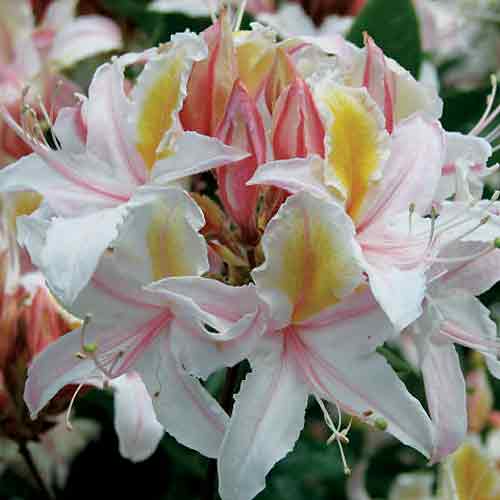
|
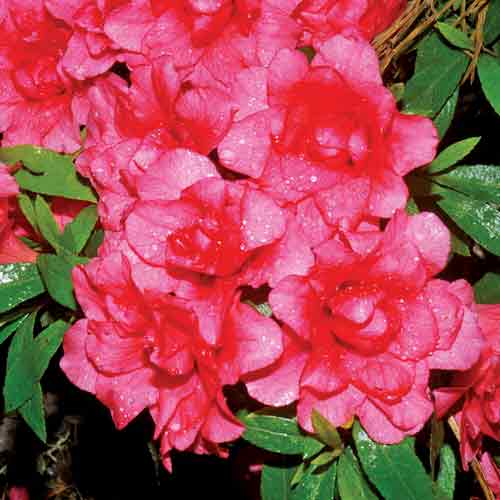
|
|
|---|---|---|
Deciduous Azalea: R. occidentale Photo by R. Stanley |
Evergreen Azalea: 'Balsaminiflorum' Photo by H. Greer |
Southwestern Region
'Bruce Brechtbill'
: Elepidote (sport of 'Unique'). Wavy pale pink flowers with a
light yellow throat held in a ball-shaped truss; a heavy, early midseason bloomer
with a compact, dense habit and excellent olive green foliage; a well-branched plant,
growing to 4' in ten years; hardy to ‑5°F and can take the heat; introduced by the
Brechtbill Nursery.
'My Lady' : Lepidote ('Forsterianum' selfed). An early spring bloomer with open white flowers, flushed pink with a light yellow throat; compact grower with a rounded habit and glossy dark green leaves; grows to about 3' in ten years; a Sumner hybrid hardy to 15°F.
R. occidentale : Deciduous Azalea. The only azalea that grows naturally west of the Rocky Mountains, being native to California and southwest Oregon; easy to grow on the west coast, but difficult elsewhere, especially in regions with heat and humidity in the summer; funnel-shaped flowers with a wonderful fragrance appear in a wide range of colors, from white to yellow, pink, and even red, usually with a yellow or orange blotch; hardy to -10°F.
'Kirin' (syn 'Coral Bells'): Evergreen Azalea (unknown.) Perhaps the best known of the Kurume hybrids which first came to the United States before World War I; one of the earliest azaleas to bloom, the entire plant covered with hose-in-hose coral pink flowers; a dense, compact plant often described as low-growing, but will grow large over time, often growing as wide as tall; hardy to zone 6b; introduced by the Domoto Brothers Nursery of Hayward, California; called 'Kirin' by its Japanese breeder, 'Coral Bells' and 'Daybreak' are names given to the cultivar in the United States.
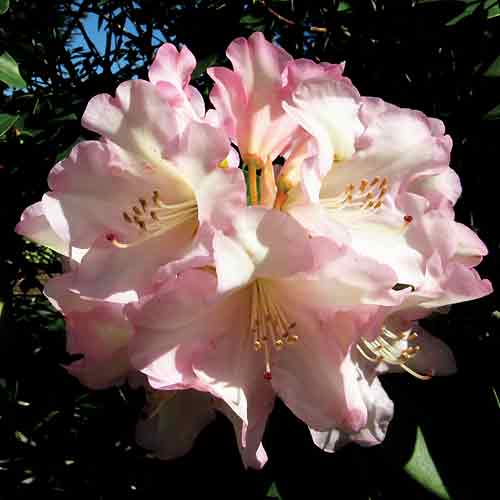
|
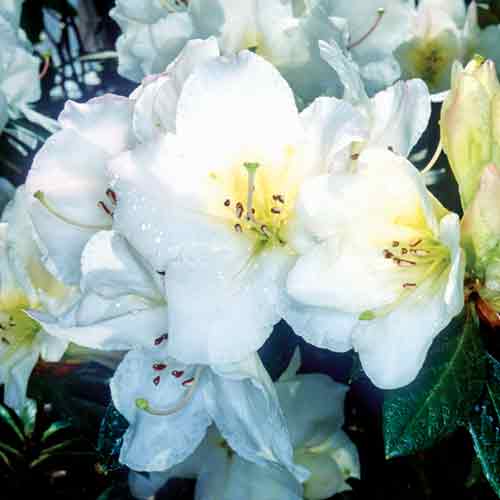
|
|
|---|---|---|
Elepidote: 'Bruce Brechtbill' Photo by D. McKiver |
Lepidote: 'My Lady' Photo by H. Greer |

|
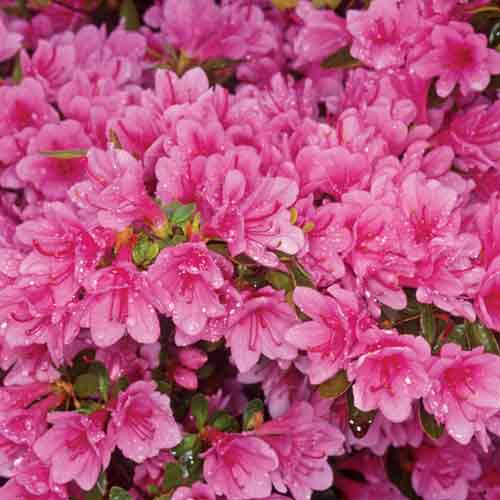
|
|
|---|---|---|
Deciduous Azalea: R. occidentale Photo by R. Stanley |
Evergreen Azalea: 'Kirin' Photo by H. Greer |
Swisher/Vireya
'Saint Cecilia'
: (
R. konori
var.
phaeopeplum
x
R. leucogigas
).
Large and fragrant wavy-edged white flowers with pink markings where the petals meet;
strong, upright grower with thick stems and large, glossy dark yellowish green leaves;
shrub-like, growing to 4' in ten years, with a variable flowering period; a Sullivan hybrid,
sometimes referred to simply as 'Cecilia'.
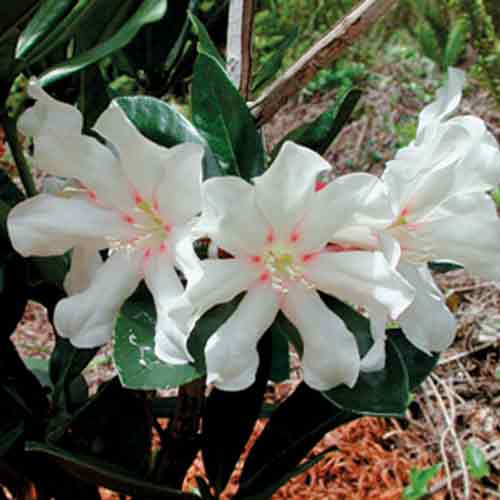
|
|---|
Vireya: 'Saint Cecilia' Photo by S. Bertelmann |

